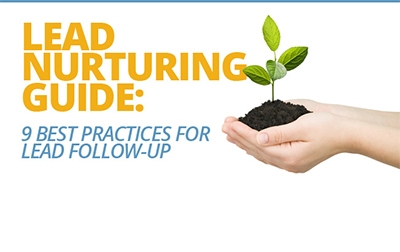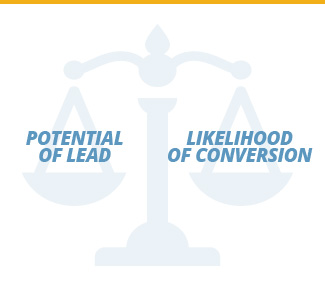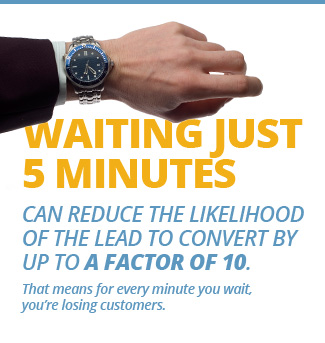Lead Nurturing Guide: 9 Best Practices for Lead Follow-up
Leads are an integral part of any salesforce strategy. Without leads the process stumbles, relying on only chance and fortune. Fostering leads is a great way to take control of your sales force, relying on expertise instead of luck.
Fostering leads can be a time-consuming and challenging endeavor. It’s difficult for a sales staff to know, for example, which leads will convert successfully into customers and clients. This implies that it can be tempting to not follow up on a lead.
Sometimes so-called quality leads can fizzle out and suspect leads can turn into big business. It’s this unpredictability that pushes many businesses to spend equal time and energy on all leads. But this may not be the best practice for lead follow up.
And yet, sometimes this every-stone-unturned strategy can be limiting in its own ways. Lead development and generation is, at the heart of the matter, about resource allocation.
If you have enough resources to develop every potential lead, that strategy makes a lot of sense. However, most businesses do not have unlimited resources to throw at lead development and generation, so there’s a balance that needs to be achieved. The potential of each lead and the likelihood of the lead to develop into a conversion is a delicate, but necessary, balance to achieve.
How to Follow Up with Leads: A Strategy
The best practices for lead follow-up begin with a strategy. Maximizing the efficiency of the interaction and the potential of the transaction is at the core of this strategy.
Your lead’s time is valuable. If roadblocks can be identified earlier in the process, it will save everyone time and money. That said, there’s no such thing as the ideal lead, and all leads will need to be coached through the process to some degree.
The trick is to get a quick handle on what your lead needs in order to successfully convert. If you can provide that need, it’s likely to be a successful experience. And determining this earlier in the process will make the entire interaction more efficient, more cost effective and more successful for every party involved.
There are several ways a lead may be generated, depending on the shape and scope of the campaign. Sometimes leads are generated through a simple pay-per-click campaign, such as Google AdWords. Sometimes they’re generated through a concerted Search Engine Optimization (SEO) drive. Other possibilities range from a simple word-of-mouth reference to the complex white-paper distribution. Nearly all lead generation methods have something in common: data. Learn more about the different types of lead nurturing programs to find a program that works best for your organization.
1. Use Big Data to Learn About Your Lead
In today’s world, big data is more valuable than gold. There are, of course, legitimate privacy concerns that go along with it, but when those concerns are managed responsibly, big data can tell you a lot about your leads.
If this data is harvested and analyzed properly, it can help you identify leads that are likely to convert and help you concentrate resources in a productive, efficient way. It can also maximize the productivity of interactions with leads, saving everyone time and money in the process.
A system for keeping track of big data is essential for developing your lead. Often, these systems can be tailored to keep track of the most important data.
For example, most online lead generators allow you to track the origin of leads. Whether your lead found you through a Google organic search or through direct traffic will tell you something about how much research your lead has done. Additionally, you can often track what online content your lead has downloaded, which means you can assess how far along your lead is in the lead conversion process.
2. Properly Select Your Metrics
Because data can be difficult to interpret, it’s important to select metrics before you begin interpreting it. Ask yourself the following questions:
- What makes for a good lead?
- What makes for a lead that still needs to be developed?
- Where should the resources go?
- How do we know which data to look at
The answers to those questions will largely depend upon the service or product you are selling. Some products and services require leads to do a substantial amount of research to be ready for the next steps. And data can help tremendously in those situations. It will help determine which leads are ready to take the next step in the lead development process.
The more you know about leads, the better you can anticipate their needs. This helps make the entire interaction more efficient. In other words, the more data you have, the greater your chances for closing the deal and converting the lead. You’ll improve best practices for lead follow up and your bottom line.
3. Respond Quickly to Leads
Most of your leads will come from the Internet, which moves at the speed of light. Even if most of your leads don’t come from online today, they likely will in the near future. Because information moves so rapidly in today’s digital world, your leads have short attention spans and high expectations.
For example, if you make a purchase on Amazon, an email confirmation of the purchase is sent within seconds. It’s a simple, automated process, but it solidifies the relationship. And, more importantly, it’s the speed consumers expect.
This implies that letting days go by before contacting leads is wasted time. Not only are you providing a window for the competition to set in, you’re also disappointing the customer’s expectations. Waiting just five minutes can reduce the likelihood of the lead to convert by up to a factor of 10. That means for every minute you wait, you’re losing customers.
4. Manage the Initial Contact
The initial contact can be difficult to manage, but it must be done so thoughtfully. If initial contact comes in the form of a white paper, for example, following up with a phone call asking “What did you think of that white paper?” within 60 seconds would be a mistake. Obviously, someone can’t read an entire white paper in under a minute.
But automating an email delivery – one with a contact name and phone number – is a great way to confirm to the lead that he or she has entered the lead process.
5. What Is Email Lead Nurturing?
Email lead nurturing is simple. Using emails, you can confirm, follow up and engage with leads. Automated processes make email lead nurturing simple.
Remember that communication is key to nurturing leads through what can often be a long process. Beginning that communication immediately sets the tone for all future interactions. Using email is an easy way to communicate with the lead right away.
6. Engage When Your Lead Is Ready to Talk
If your lead contacts you with a question, research conducted by the Harvard Business Review suggests that responding within an hour gives you seven times better a chance at a meaningful interaction than if you respond one hour later.
The cardinal rule of lead nurturing is to engage with your lead when your lead is ready to talk. Everybody, leads included, have moods and mindsets. If they’ve built themselves up to talk about your product, you’re missing an opportunity by not being there when they’re ready.
It’s worth noting that keeping great lead data can enable various team members to efficiently interact with leads. Ensuring that a team member is always available is a great way to form a seamless path of immediate communication.
Leads are more likely to covert when you’re readily available. And they’re less likely to find reasons to seek out your competition.
7. Invest in Excellent CRM Resources
We’ve already established that data and communications are both key to developing your leads. Those tasks seem pretty straightforward, but they can also be complex and time consuming. Managing those tasks efficiently is why many businesses invest in Customer Relationship Management platforms, or CRM.
CRM is a broad term. It’s either provided by software or people, but, regardless of the provider, it enables effectively managed interactions with and data from leads.
Perhaps the most common CRM software available is Salesforce, which allows you to use technology to achieve lead follow up best practices. This CRM is scalable, which makes it a perfect fit for businesses both large and small. It’s capable of handling everything from email marketing to competitor tracking to sales collaboration.
Essentially, Salesforce can help you keep in contact with leads by giving your team access to great information, which Salesforce can be set up to selectively gather. Of course, Salesforce is not the only option. There’s a myriad of software out there, including NetSuite, OnContact, and SalesNexus. All of them offer software with support.
8. Consider Help from the Outside
Sometimes it’s more efficient to let someone else connect the dots for you. There are plenty of resources available that combine marketing efforts (essentially, lead generation) with lead nurturing. Sometimes an outside eye can help accomplish this combination in a way that insiders simply can’t fathom.
The size and scope of what each business hopes to accomplish will determine the degree of support necessary. Customer Relationship Management can be a fulltime occupation, one that you simply don’t have the time or expertise to effectively manage on your own.
If that’s the case, a software solution such as Salesforce will, on its own, do little to put a dent into return on investment. You won’t have the time to use the software to its full potential. The solution, then, is to partner with experts in that field. Your CRM network with established practices will set you up for success for years to come.
9. Give it Away for Free
Creating great content, such as white papers, e-books and social media posts, is a vital component of lead nurturing. Content is designed to educate your potential leads and encourage them to realize their need for your products or services.
A lead that comes to you – an inbound lead – is far more likely to convert into a customer than almost any other type of lead.
Providing valuable content at the beginning of the relationship is only the start of the nurturing process. Lead follow-up best practices suggest that you continue to provide access to helpful, engaging content.
Education is incredibly valuable. When you offer it for free, you make the lead more likely to return. And the more a lead returns, the more chances you have to convert the lead and continue growing your business. You can automate this process with a lead follow up email, which drastically improves your efficiency.
Why Nurture Leads?
In conclusion, leads are the fuel that keep your business running. In some very literal ways, leads are the future of your business. But not all leads will be equal. Some will be sales-ready and others will be marketing-qualified. And, of course, there are many leads that fall somewhere in the middle.
Lead nurturing is simply the art of finding out which leads fit into which categories. There are many ways to accomplish that, such as using analytics and a CRM system.
The beauty of lead nurturing is that it gives you the opportunity to calibrate your response to each individual lead, therefore increasing the chances of a successful conversion.
Lead nurturing for the complex sale can also make your entire operation more efficient. Following lead nurturing best practices and placing your leads into categories allows you to allocate resources based on likelihood to convert and what the lead needs to convert. Lead nurturing allows you to guide leads through a complex process based on both the needs of your sales team and the needs of your lead.
Stay Informed
Leads come into any nurturing process with a set of expectations, and they judge you based on how well you meet those expectations. You can automate part of that process, with the help of CRMs, but you also need to have a plan. The Digital Bridge can help with that plan by keeping you updated with the latest industry news and knowledge.
A logistically sound, strategically planned lead nurturing campaign will help you maximize your efficiency and optimize your results. More satisfied leads mean higher numbers of conversions. And at the end of the day, that means higher profits, which will keep you in business longer.
The more information you have at your disposal, the better position you’re in for the long term. If you want to know more about how to do lead nurturing and learn more about growing your business through customer relationship management, sign up for our newsletter for our POV and expertise.








